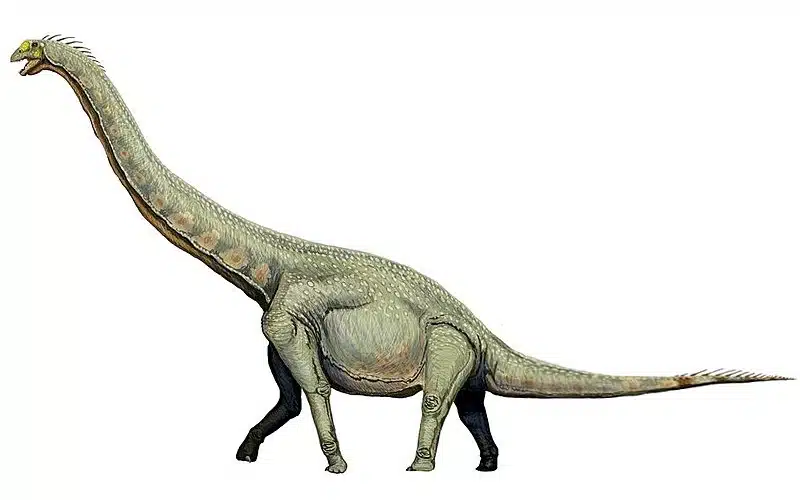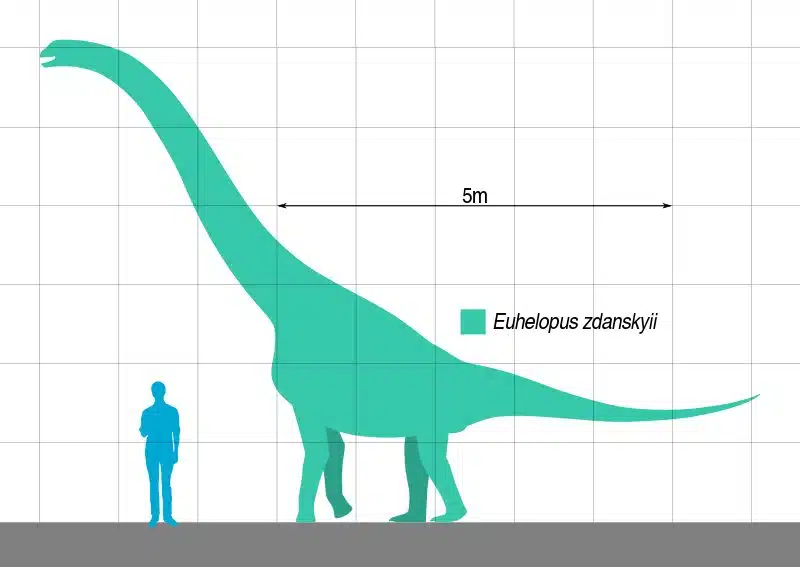Welcome to a journey through time to the Early Cretaceous period where Euhelopus, a unique sauropod dinosaur, roamed the earth. This fascinating creature, whose name intriguingly translates to “True Marsh Foot”, is a testament to the diverse and complex world of dinosaurs.
In this article we will explore the world of Euhelopus, looking into its origins, unique features, and the environment it thrived in. We’ll also touch on the significant discoveries and research that have shaped our understanding of this remarkable dinosaur.
Euhelopus Key Facts
| Keyword | Fact |
|---|---|
| Euhelopus pronunciation | yoo-hel-oh-pus |
| Meaning of name | True Marsh Foot |
| Group | Sauropod |
| Type Species | Euhelopus zdanskyi |
| Diet | Herbivore |
| When it Lived | 139.8 to 122.4 MYA |
| Period | Early Cretaceous |
| Epoch | Valanginian to Early/Lower Aptian |
| Length | 36.0 ft |
| Height | 20.0 ft |
| Weight | 3.9 tons |
| Mobility | Moved on all four |
| First Discovery | 1913 by H.C. T’an |
| Location of first find | Shandong, China |
| First Described by | 1929 by Carl Wiman |
| Holotype | PMU R233 |
Euhelopus Taxonomy and Timeline

The name of this dinosaur derived from the Greek words ‘eu’ meaning “true”, ‘helos’, meaning “swamp”, and ‘pous’, meaning “foot”. This name is a testament to the creature’s marshy habitat and its distinctive foot structure. This sauropod dinosaur, belonging to the Euhelopodidae family, is a fascinating subject of study for paleontologists worldwide.
Euhelopus zdanskyi is the type species of this genus and a testament to the diversity within the Sauropoda group. As an herbivore, this dinosaur played a significant role in the ecosystem of its time, contributing to the balance of flora and fauna. The timeline of this dinosaur is traced back to the Early Cretaceous period, specifically from the Valanginian to Early/Lower Aptian epochs.
Listen to Pronunciation
Discovery & Fossil Evidence
Euhelopus was first discovered in 1913 by H.C. T’an in Shandong, China. This discovery marked a significant milestone in the field of paleontology, as it represented the first dinosaur scientifically investigated from China. The dinosaur was later described by the Swedish paleontologist Carl Wiman in 1929, further expanding our understanding of this unique creature.

It was initially named Helopus, but this name had already been given to a bird. The name was changed to Euhelopus. Even though there is a plant with the same genus name, this name was accepted because the two organisms belong to different taxonomic kingdoms.
This dinosaur has left behind a rich trail of fossil evidence that provide researchers with valuable insights into its physical characteristics and lifestyle. The holotype is particularly noteworthy. This partial skeleton includes the skull and lower jaws and provides a glimpse into the dinosaur’s physical structure and lifestyle.
It is known to have inhabited regions such as Liaoning and Xinjiang in addition to its initial discovery site in Shandong, China. The discovery of five different specimens has allowed paleontologists to piece together a more comprehensive picture of this dinosaur’s life and times.
Euhelopus Size and Description
Sauropods are a group known for their large size, long necks, and quadrupedal stance. This dinosaur’s body shape was typical of sauropods, with a long, slender neck and a tail that balanced its body. It moved on all four legs, a trait that is also characteristic of sauropods.
Its head was small compared to its body, another common feature among sauropods. The vertebrae of the Euhelopus were unique, with elongated cervical vertebrae that contributed to its long neck. Its limbs were robust to support the weight of its large body and its tail served as a counterbalance to its long neck.
Size and Weight of Type Species

Paleontologists have determined that the Euhelopus had an approximate length of 36.0 ft and stood about 20.0 ft tall. With an estimated weight of 3.9 tons, this dinosaur was undeniably a significant presence in its environment.
Euhelopus exemplified the large stature typical of sauropods. Its long neck and tail would have contributed notably to its overall length. Though these figures are derived from complete fossils, they remain as educated estimates based on the evidence available from that time.
The Dinosaur in Detail
This is a fascinating dinosaur with unique features that set it apart from other sauropods. Its elongated cervical vertebrae, for instance, contributed to its long neck. This distinctive feature likely played a crucial role in its survival and adaptability.
These elongated vertebrae would have allowed this herbivorous dinosaur to reach vegetation that other herbivores could not, giving it a competitive edge in its environment. This adaptability is a testament to the dinosaur’s survival instincts and its ability to thrive in various conditions.
Notable specimens of Euhelopus, such as the holotype, have provided valuable insights into this dinosaur’s physical characteristics and lifestyle. These specimens have played a crucial role in shaping our understanding of this herbivore and its place in the dinosaur world.
Euhelopus in its Natural Habitat
This dinosaur lived during the Early Cretaceous period. This was a time when the earth was undergoing significant changes. The climate was warm and the geography was diverse, with marshy areas, forests, and open plains. This diversity of habitats provided a rich environment for a variety of plant and animal life.
As an herbivore, Euhelopus would have fed on the abundant vegetation available in its environment. Its long neck would have allowed it to reach vegetation that other herbivores could not in order to give it a competitive edge. The dinosaur’s diet would have consisted primarily of ferns, cycads, and possibly some types of conifers.
Like other sauropods, it was a quadruped that moved on all four legs. This mode of locomotion and its large size would have made it a slow but steady mover. Its size would have offered some protection from predators but it’s likely that it still had to contend with threats from large carnivorous dinosaurs.
Like many other dinosaurs, it was likely a social creature. While there is no direct evidence to suggest that it lived in herds, it’s plausible that it did since this behavior is common among many sauropods. Living in groups could have offered additional protection from predators and made it easier to find food and mates.
Interesting Points about Euhelopus
- Euhelopus was originally named Helopus until it was discovered that the name had already been used for a bird. The name was altered to Euhelopus by Alfred Romer in 1956.
- It was similar to some sauropods in that the forelegs were proportionately longer than the rear legs, resulting in a sloping back.
- This unique body structure might have allowed the dinosaur extra reach, but the height at which sauropods carried their heads is a matter of contention for some paleontologists.
- This was one of the first dinosaurs scientifically investigated from China, marking a significant milestone in the field of paleontology.
- It is known to have inhabited regions such as Liaoning and Xinjiang, in addition to its initial discovery site in Shandong, China.
Contemporary Dinosaurs
In the vast expanse of prehistoric time, Euhelopus shared its existence with a captivating array of contemporaries. Among these were the Helioceratops, Qiaowanlong, and Gobisaurus. Each of these Asian dinosaurs played their own unique role in the intricate push and pull of survival and competition that defined their era.
Helioceratops was smaller in comparison to Euhelopus. It might have been a nimble forager, adept at navigating the dense vegetation. Its presence suggests a dynamic of coexistence, where size and agility found a delicate balance. Qiaowanlong shared a similar herbivorous diet with Euhelopus. Their coexistence paints a picture of possible competition for the same resources, a testament to the survival instincts of these magnificent creatures.
Gobisaurus was considerably larger and more robust and introduces a different dynamic. As a potential predator, it might have posed a significant threat to Euhelopus. This predator-prey relationship, while speculative, adds a layer of complexity to our understanding of this environment. It underscores the reality of life in the prehistoric world through a constant interplay of survival, adaptation, and coexistence.
List Of All Dinosaurs
We have created a list of all dinosaurs we have covered here, sorted across the seven main groups of dinosaurs. We also include information about their type of diet, (omnivore, herbivore or carnivore) and the time they lived.
Frequently Asked Questions
The name translates to “True Marsh Foot”, derived from the Greek words ‘eu’ meaning true, ‘helos’, meaning “swamp”, and ‘pous’, meaning “foot”.
It lived during the Early Cretaceous period, specifically from the Valanginian to Early/Lower Aptian epochs, between 139.8 and 122.46 million years ago.
It was an herbivore, feeding on the abundant plant matter available in its environment. Its long neck would have allowed it to reach vegetation that others could not.
It was first discovered in Shandong, China, by H.C. T’an in 1913.
The Euhelopus, like other sauropods, was a quadruped. This means that it moved on all four legs.
Sources
- https://www.ivpp.cas.cn/cbw/gjzdwxb/xbwzxz/201106/P020110622317291002469.pdf
- https://citeseerx.ist.psu.edu/document?repid=rep1&type=pdf&doi=6cf978b7c48c3a9c2e598556112bdf992c367d85
- https://www.tandfonline.com/doi/full/10.1080/14772019.2023.2171818
- https://royalsocietypublishing.org/doi/10.1098/rsos.191057
- https://academic.oup.com/zoolinnean/article/168/1/98/2544489
Please note that the information in this article is based on various sources, drawing on scientific research, fossil evidence, and expert analysis. The aim is to provide a comprehensive and accurate overview of the Euhelopus, but please be aware that our understanding of dinosaurs and their world is constantly evolving as new discoveries are made.
This article was last fact-checked: Joey Arboleda, 06-14-2023
Featured Image Credit: DiBgd, CC BY-SA 3.0, via Wikimedia Commons
